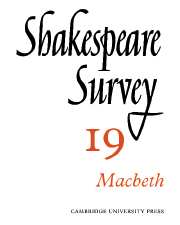Book contents
- Frontmatter
- ‘Macbeth’ in the Twentieth Century
- The Criminal as Tragic Hero: Dramatic Methods
- Antithesis in ‘Macbeth’
- Why was Duncan’s Blood Golden?
- Image and Symbol in ‘Macbeth’
- ‘Macbeth’ and The Furies
- Hell-Castle and its Door-Keeper
- ‘His Fiend-Like Queen’
- The Fiend-Like Queen: A Note on ‘Macbeth’ and Seneca’s ‘Medea
- Shakespeare at Street Level
- New Findings with Regard to the 1624 Protection List
- Shakespeare Productions in the United Kingdom: 1965
- The Royal Shakespeare Company 1965
- The Year's Contributions to Shakespearian Study: 1 Critical Studies
- 2 Shakespeare’s Life, Times and Stage
- 3 Textual Studies
- Index
- Plate Section
‘Macbeth’ in the Twentieth Century
Published online by Cambridge University Press: 28 March 2007
- Frontmatter
- ‘Macbeth’ in the Twentieth Century
- The Criminal as Tragic Hero: Dramatic Methods
- Antithesis in ‘Macbeth’
- Why was Duncan’s Blood Golden?
- Image and Symbol in ‘Macbeth’
- ‘Macbeth’ and The Furies
- Hell-Castle and its Door-Keeper
- ‘His Fiend-Like Queen’
- The Fiend-Like Queen: A Note on ‘Macbeth’ and Seneca’s ‘Medea
- Shakespeare at Street Level
- New Findings with Regard to the 1624 Protection List
- Shakespeare Productions in the United Kingdom: 1965
- The Royal Shakespeare Company 1965
- The Year's Contributions to Shakespearian Study: 1 Critical Studies
- 2 Shakespeare’s Life, Times and Stage
- 3 Textual Studies
- Index
- Plate Section
Summary
DISINTEGRATION
All editions of Macbeth derive from one single and authoritative text—that of the First Folio. The number of substantive emendations that modern editors see fit to introduce is quite small; and there are no passages so hopelessly corrupt that the sense is obscured. All this would argue an uncomplex task for the editor, and a simple and mercifully brief narrative for the historian of criticism. This turns out not to be the case. The discovery that the two songs (whose first lines are invoked in III, V and, again, in IV, i) exist in full texts in the manuscript of Middleton’s The Witch has unloosed a flood of disintegration. I am more or less discounting, of course, the views of chronic disintegrators like J. M. Robertson who found (Literary Detection, 1931) that ‘there is clear literary evidence of the past existence of a lost pre-Shakespearean Macbeth by Kyd’; Middleton he found to have written the Witch-scenes, the Porter-scene and the couplet tags throughout the play; there is a case for Heywood’s authorship of the closing scene. IV, iii and I, ii are non-Shakespearian but unassigned. More impressive are the views of Clark and Wright, not given to rashness, who excised whole areas of the play from the Shakespeare canon, finding the bleeding sergeant in I, ii an ‘absurdity’, his metre ‘slovenly’ and his ‘bombastic phraseology . . . not like Shakespeare’s language even when he is most bombastic’.
- Type
- Chapter
- Information
- Shakespeare Survey , pp. 1 - 11Publisher: Cambridge University PressPrint publication year: 1967

